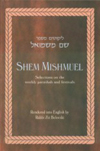 Vampire Weekend's Surprising Jewish Stories
Vampire Weekend's Surprising Jewish Stories
5 min read
The first part of the Torah portion describes the final day of the inauguration ceremony of the Mishkan (the Tabernacle). After Aharon and the Children of Yisrael had brought special offerings, he and Moshe blessed the people, and the Divine Presence finally rested on the Mishkan. The Ramban notes something very interesting about these communal offerings:
Why did the people have to bring more offerings than Aharon? Because He [God] had said to them [the people], "You have sin on your hands at the beginning and sin on your hands at the end." You have sin on your hands at the beginning [of your nationhood] - as the verse says [with reference to the sale of Yosef], And they slaughtered a male goat (Bereishis 37:31). Let them bring a male goat to atone for the incident of the male goat... (Ramban, Vayikra 9:3)
The he-goat brought by the people at the induction ceremony was to atone for the sale of Yosef many years before. But what has this sale to do with the Mishkan and its inauguration, and why did God deem it necessary for the people to atone for it now?
* * *
THE OHEL MO'ED
Throughout Vayikra and elsewhere in the Torah, the Mishkan is referred to as "the Ohel Mo'ed," usually translated as "Tent of Meeting." It was a place where the whole of klal Yisrael assembled to perform their communal spiritual duties. And once the Mishkan was constructed, private altars for animal sacrifices were forbidden, as all offerings had to be brought to the spiritual center. This, as always, reflected a spiritual reality as well as a physical law. The existence of the Mishkan as the single focus of the nation meant that they, too, had reached a level at which they had achieved real theological unity - they were the chosen nation of God, truly connected with the Divine. This was the "meeting" in both physical and spiritual terms which the Ohel Mo'ed represented.
* * *
YOSEF
The mystics understand that Yosef was a person of unique character. His specialty, as it were, was to gather all of the spiritual contributions of the other members of his family and to direct them toward God. This is reflected by the fact that he gathered all of the food in Egypt and distributed it as appropriate. He is known as the head: just as the head is in control of the body, so too was Yosef the spiritual leader and controller of the others. It should be apparent that this character is similar to that expressed by the Ohel Mo'ed.
When the brothers sold Yosef, opposing the influence that Yosef could bring to the world, they exposed a defect in their ability to appreciate and utilize the power of gathering which he embodied. This defect, we may assume, was passed on to their descendants and was still present in the national character of klal Yisrael at the time of the construction of the Mishkan. So before the Divine Presence could enter the Mishkan, enabling it to fulfill its intended function of communal unity and singularity of purpose, this national character flaw had to be expunged. Thus the people were required to bring a male goat to atone for the sale of Yosef at the inauguration ceremony.
* * *
THE TEN MARTYRS
This will help us to understand another related issue. The sad story of the ten martyrs is well known. We read about it in the mussaf prayer of Yom Kippur and in the dirges of Tishah B'Av. Ten of the greatest sages in Jewish history were cruelly murdered by the Romans to atone for the sale of Yosef. We acknowledge that in some way these ten martyrs lost their lives as an atonement for the sin of the ten brothers who had sold Yosef centuries earlier.
This is obviously a complex issue, but let us consider one point: why did this happen at the time of the Roman domination of Eretz Yisrael? Why was this punishment not executed at an earlier time? And why at the end of the second Beis HaMikdash era?
We may suggest that while the Mishkan and later its replacement, the Beis HaMikdash, stood, the forces that united klal Yisrael were in operation. As we have seen, the primary function of the Ohel Mo'ed was to link and unite the people. Thus the traces remaining of the sale of Yosef could not exert themselves, as the opposite force was too strong. However, toward the end of the second Beis HaMikdash period, baseless hatred was rife among Jews; indeed, it was ultimately destroyed for this evil. This expressed a fundamental lack of unity, enabling the remaining vestiges of the sale to reassert themselves and to demand, as it were, a price - the ten martyrs.
We have proposed that baseless hatred causes disunity. Actually, this can also happen in the reverse order. For when there is no unifying force among the members of klal Yisrael, this causes an increase in senseless hatred. Both views are true, for this sad situation is in fact a vicious circle. Hatred causes disunity, which in turn causes more hatred. May God save us from both.
 Excerpted from Shem MiShmuel by the Sochatchover Rebbe, rendered into English by Rabbi Zvi Belovski, published by Targum Press. Click here to order.
Excerpted from Shem MiShmuel by the Sochatchover Rebbe, rendered into English by Rabbi Zvi Belovski, published by Targum Press. Click here to order.
